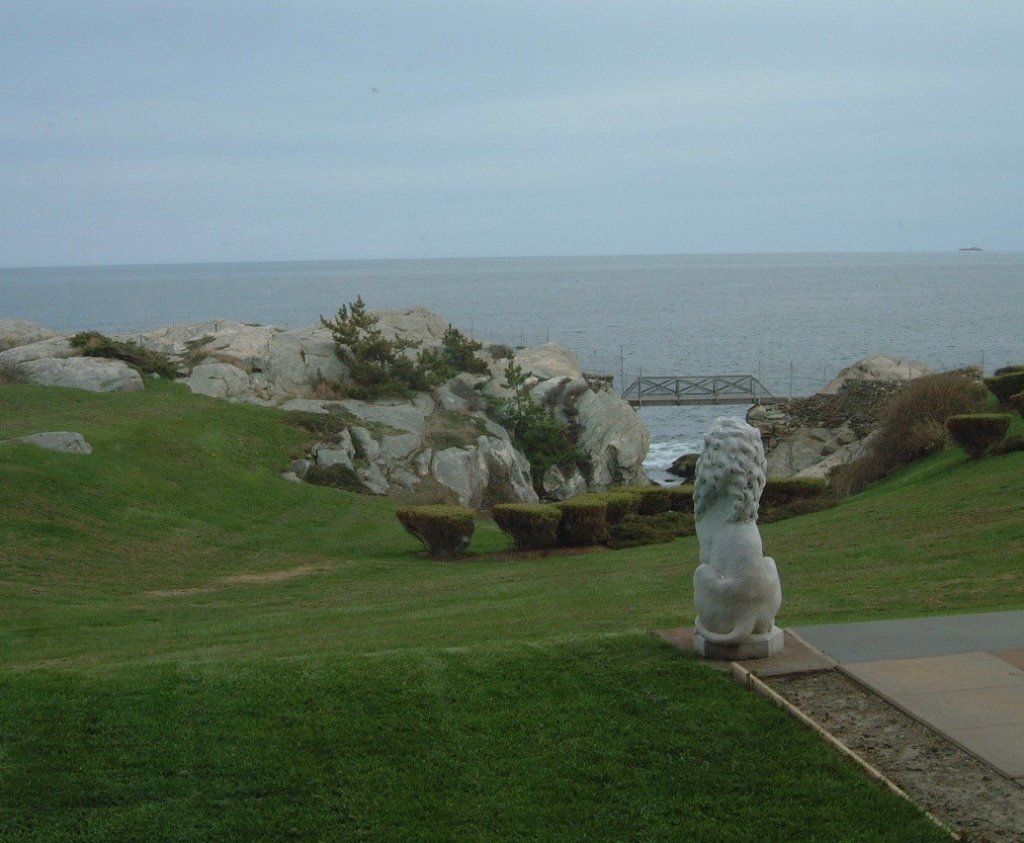BY JANET STEINBERG
Newport,
Rhode Island, a beautifully preserved walking-city with an architectural
tapestry dating back to the 17th century, pays homage to the past as
it celebrates the present.
Rhode Island, a beautifully preserved walking-city with an architectural
tapestry dating back to the 17th century, pays homage to the past as
it celebrates the present.
 |
| WELCOME TO NEWPORT, RHODE ISLAND |
President George Washington sat in
the synagogue here. Philanthropist Judah Touro is buried here; and
the founders of America’s industrial society summered here. Founded in
1639 by a group of dissidents seeking religious and political freedom not
available in some northern colonies, Newport became a summer refuge for the
nation’s elite.
the synagogue here. Philanthropist Judah Touro is buried here; and
the founders of America’s industrial society summered here. Founded in
1639 by a group of dissidents seeking religious and political freedom not
available in some northern colonies, Newport became a summer refuge for the
nation’s elite.
Their “summer cottages” were, in
reality, the grandest of grand mansions that outdid one another.
Newport’s mansions permit visitors to peek into the Gilded Age that was
experienced at the dawn of the 20th century. Wealthy,
powerful, men and women, who transformed America from its agricultural
beginnings to an international industrial power, built their “summer cottages”
in Newport. Three Newport mansions, The Breakers, Marble House, and The Elms,
all rank in the top 20 of the most visited historic house museums in the United
States.
reality, the grandest of grand mansions that outdid one another.
Newport’s mansions permit visitors to peek into the Gilded Age that was
experienced at the dawn of the 20th century. Wealthy,
powerful, men and women, who transformed America from its agricultural
beginnings to an international industrial power, built their “summer cottages”
in Newport. Three Newport mansions, The Breakers, Marble House, and The Elms,
all rank in the top 20 of the most visited historic house museums in the United
States.
The Breakers (1895) is a 70-room
“cottage” built by leading American Architect Richard Morris Hunt.
Cornelius Vanderbilt II, patriarch of America’s wealthiest family, ordered his
estate to include interiors of rich marbles, gilded rooms, and open-air
terraces offering magnificent ocean views.
“cottage” built by leading American Architect Richard Morris Hunt.
Cornelius Vanderbilt II, patriarch of America’s wealthiest family, ordered his
estate to include interiors of rich marbles, gilded rooms, and open-air
terraces offering magnificent ocean views.
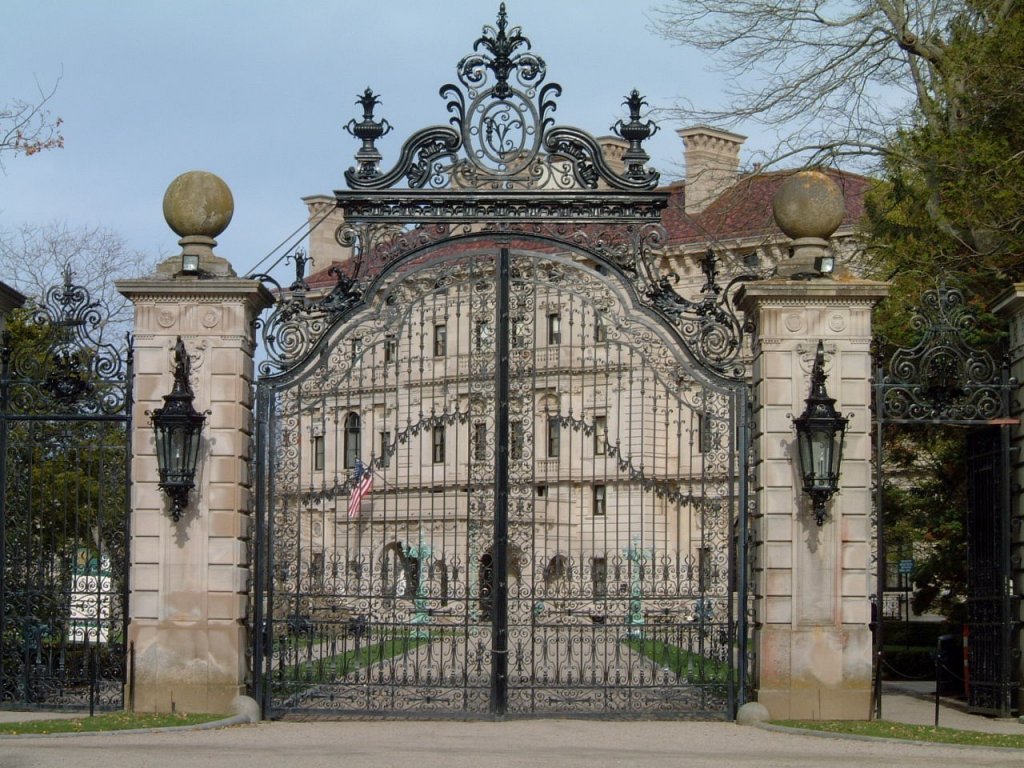 |
| ENTRY GATE TO THE BREAKERS |
Marble House (1892) gives an
intimate look at the life of Alva Vanderbilt and her “temple to the
arts”. William K. Vanderbilt asked architect Hunt to build him the best
living accommodations that money could buy. The result was Marble House,
a “cottage” that cost $11-million and contained some 500,000 cubic feet of
marble.
intimate look at the life of Alva Vanderbilt and her “temple to the
arts”. William K. Vanderbilt asked architect Hunt to build him the best
living accommodations that money could buy. The result was Marble House,
a “cottage” that cost $11-million and contained some 500,000 cubic feet of
marble.
The Elms (1901), commissioned by
Philadelphia coal magnate Edward J. Berwind, is an elegant French-style chateau
that was a technological marvel for its time.
Philadelphia coal magnate Edward J. Berwind, is an elegant French-style chateau
that was a technological marvel for its time.
 |
| THE ELMS |
Rough Point (1891) was built for
Frederick W. Vanderbilt, seventh child of William H. Vanderbilt and grandson of
Cornelius Vanderbilt. In 1925, several owners later, it was left to Doris
Duke the 13-year old daughter of James B. Duke, founder of the American Tobacco
Company, when he passed away. Doris Duke, dubbed by the media as the
“Million Dollar Baby” and “The Richest Woman in the World” lived at Rough Point
from 1925 until her death in 1993.
Frederick W. Vanderbilt, seventh child of William H. Vanderbilt and grandson of
Cornelius Vanderbilt. In 1925, several owners later, it was left to Doris
Duke the 13-year old daughter of James B. Duke, founder of the American Tobacco
Company, when he passed away. Doris Duke, dubbed by the media as the
“Million Dollar Baby” and “The Richest Woman in the World” lived at Rough Point
from 1925 until her death in 1993.
The Gothic-style, 105-room estate,
situated in a dramatic setting along Newport’s famous Cliff Walk overlooking
the Atlantic Ocean, is a living monument to Doris Duke and her passion for the
finer things in life. It is a rare opportunity to see artwork by
Gainsborough, Bol, Van Dyck, Reynolds and Renoir displayed in an intimate
setting.
situated in a dramatic setting along Newport’s famous Cliff Walk overlooking
the Atlantic Ocean, is a living monument to Doris Duke and her passion for the
finer things in life. It is a rare opportunity to see artwork by
Gainsborough, Bol, Van Dyck, Reynolds and Renoir displayed in an intimate
setting.
 |
| THE MORNING ROOM AT ROUGH POINT |
The mansions, precariously perched
on ocean-view bluffs, are truly grand, but it is a simple synagogue, tucked
away on a quiet street in downtown Newport, that might well be the most
historic structure in town.
on ocean-view bluffs, are truly grand, but it is a simple synagogue, tucked
away on a quiet street in downtown Newport, that might well be the most
historic structure in town.
Touro Synagogue, dedicated in1763
and designated a National Historic Site in 1946, is the oldest synagogue in the
United States and the only one which survives from the Colonial
era. The synagogue’s simple Georgian exterior conceals a dramatic
2-story Palladian interior. It is a skillful combination of
classical Italian architecture with functions of the Sephardic Jewish
ritual.
and designated a National Historic Site in 1946, is the oldest synagogue in the
United States and the only one which survives from the Colonial
era. The synagogue’s simple Georgian exterior conceals a dramatic
2-story Palladian interior. It is a skillful combination of
classical Italian architecture with functions of the Sephardic Jewish
ritual.
During a visit to Newport in 1790,
President Washington was presented with an address from Moses Seixas, warden of
the synagogue. In his reply, President Washington repeated Seixas’s
key phrases and wrote: “…For happily, the Government of the United States,
which gives to bigotry no sanction, to persecution no assistance requires only
that they who live under its protection should demean themselves as good
citizens, in giving it on all occasions their effectual support.” A
facsimile of this historic document is exhibited on the west wall of the
Synagogue and a reproduction is available in the gift shop. More
than 30,000 visitors a year come to Touro Synagogue where history, tradition,
and the ideal of religious tolerance and freedom converge in a place of
exquisite beauty and distinguished design.
President Washington was presented with an address from Moses Seixas, warden of
the synagogue. In his reply, President Washington repeated Seixas’s
key phrases and wrote: “…For happily, the Government of the United States,
which gives to bigotry no sanction, to persecution no assistance requires only
that they who live under its protection should demean themselves as good
citizens, in giving it on all occasions their effectual support.” A
facsimile of this historic document is exhibited on the west wall of the
Synagogue and a reproduction is available in the gift shop. More
than 30,000 visitors a year come to Touro Synagogue where history, tradition,
and the ideal of religious tolerance and freedom converge in a place of
exquisite beauty and distinguished design.
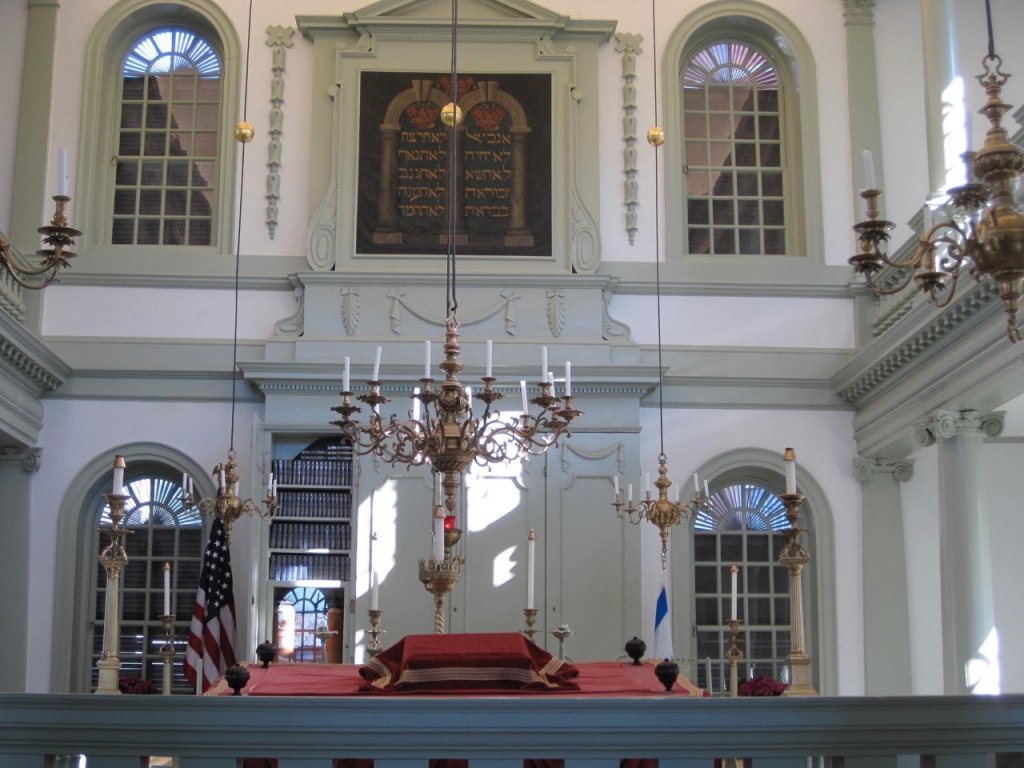 |
|
TOURO SYNAGOGUE
|
A short walk up the hill from Touro
Synagogue is Touro, the Ancient Town Cemetery, also called The
Colonial Jewish Cemetery of New England. Consecrated in 1677, the
cemetery holds the remains of Judah Touro. This quiet burial ground
also served as the inspiration for Henry Wadsworth Longfellow’s poem, “The
Jewish Cemetery at Newport’. An excerpt from Longfellow’s poem best
describes the cemetery:
Synagogue is Touro, the Ancient Town Cemetery, also called The
Colonial Jewish Cemetery of New England. Consecrated in 1677, the
cemetery holds the remains of Judah Touro. This quiet burial ground
also served as the inspiration for Henry Wadsworth Longfellow’s poem, “The
Jewish Cemetery at Newport’. An excerpt from Longfellow’s poem best
describes the cemetery:
And
these sepulchral stones, so old and brown,
these sepulchral stones, so old and brown,
That
pave with level flags their burial-place,
pave with level flags their burial-place,
Seem
like the tablets of the Law, thrown down
like the tablets of the Law, thrown down
And
broken by Moses at the mountain’s base.
broken by Moses at the mountain’s base.
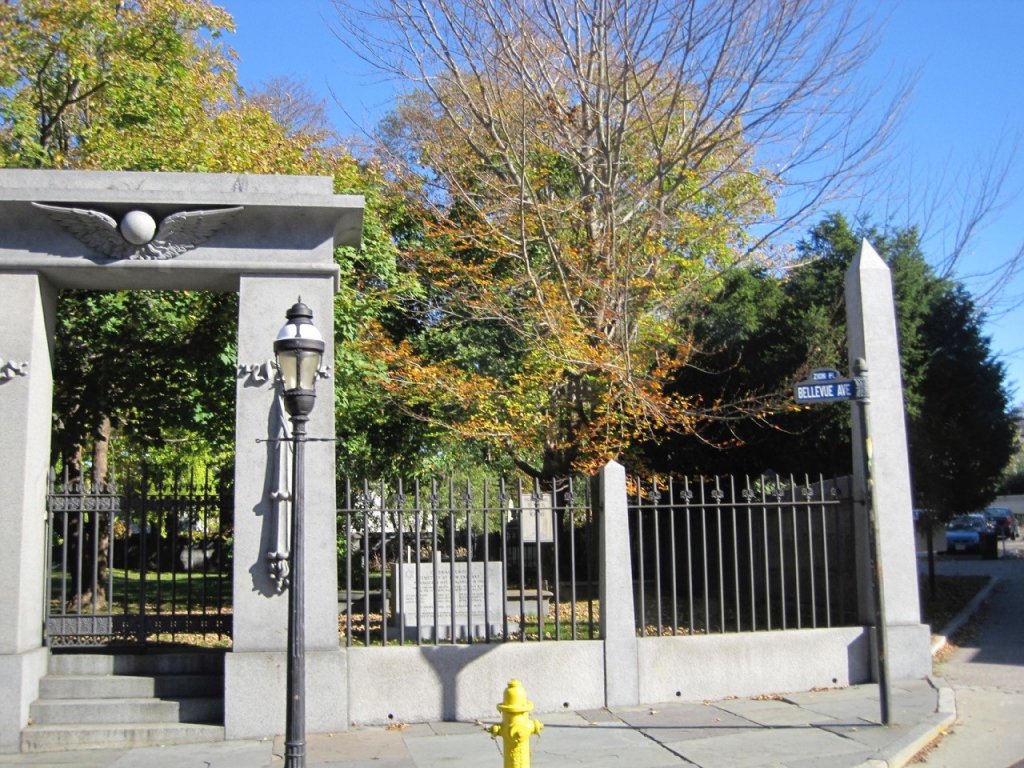 |
|
ARCHITECT ISAIAH ROGERS’ EGYPTIAN
REVIVAL GATE TO THE TOURO CEMETERY |
You can stroll through history on
Newport’s dramatic 3.5 mile Cliff Walk where paved walkways and stone paths
wind along the island’s southeastern edge, bordered on one side by the massive
“summer cottage” of America’s turn-of-the-century elite and on the other by
granite cliffs and pounding surf of the Atlantic.
Newport’s dramatic 3.5 mile Cliff Walk where paved walkways and stone paths
wind along the island’s southeastern edge, bordered on one side by the massive
“summer cottage” of America’s turn-of-the-century elite and on the other by
granite cliffs and pounding surf of the Atlantic.
Newport, Rhode Island, called
America’s first Resort” is a city of firsts. In 1687, it was the first
American city to pass a traffic ordinance. It had the first church
steeple in the United States; was the site of the first of the thirteen
colonies’ Declaration of Independence in May of 1776; it was home of the first
permanent Quaker settlement in America; operated the first ferry service in
1657; had the first gas streetlights in 1803; and, as we already know, the
first Jewish synagogue in America. Newport also bills itself as The
Sailing Capital of the World. You can take to the water for a sunset sail
on lovely Narragansett Bay, or watch one of the many annual regattas, races,
and sailing festivals that take place off Newport.
America’s first Resort” is a city of firsts. In 1687, it was the first
American city to pass a traffic ordinance. It had the first church
steeple in the United States; was the site of the first of the thirteen
colonies’ Declaration of Independence in May of 1776; it was home of the first
permanent Quaker settlement in America; operated the first ferry service in
1657; had the first gas streetlights in 1803; and, as we already know, the
first Jewish synagogue in America. Newport also bills itself as The
Sailing Capital of the World. You can take to the water for a sunset sail
on lovely Narragansett Bay, or watch one of the many annual regattas, races,
and sailing festivals that take place off Newport.
Fresh seafood is found all along the
New England coast, and Newport restaurants like The Black Pearl do it
best. Black Pearl Clam Chowder and a Two
and One Half Pound Lobster, grilled or steamed, are worth a try. Follow
that up with Key Lime Pie, Chocolate Pecan Pie or Apple Raisin Bread Pudding.
New England coast, and Newport restaurants like The Black Pearl do it
best. Black Pearl Clam Chowder and a Two
and One Half Pound Lobster, grilled or steamed, are worth a try. Follow
that up with Key Lime Pie, Chocolate Pecan Pie or Apple Raisin Bread Pudding.
If you are lucky enough to play
tennis on the legendary grass courts at The International Tennis Hall of Fame,
you can work off some of those Black Pearl calories. The Newport Casino,
a National Historic Landmark built in 1880, is home to the International Tennis
Hall of Fame & Museum.
tennis on the legendary grass courts at The International Tennis Hall of Fame,
you can work off some of those Black Pearl calories. The Newport Casino,
a National Historic Landmark built in 1880, is home to the International Tennis
Hall of Fame & Museum.
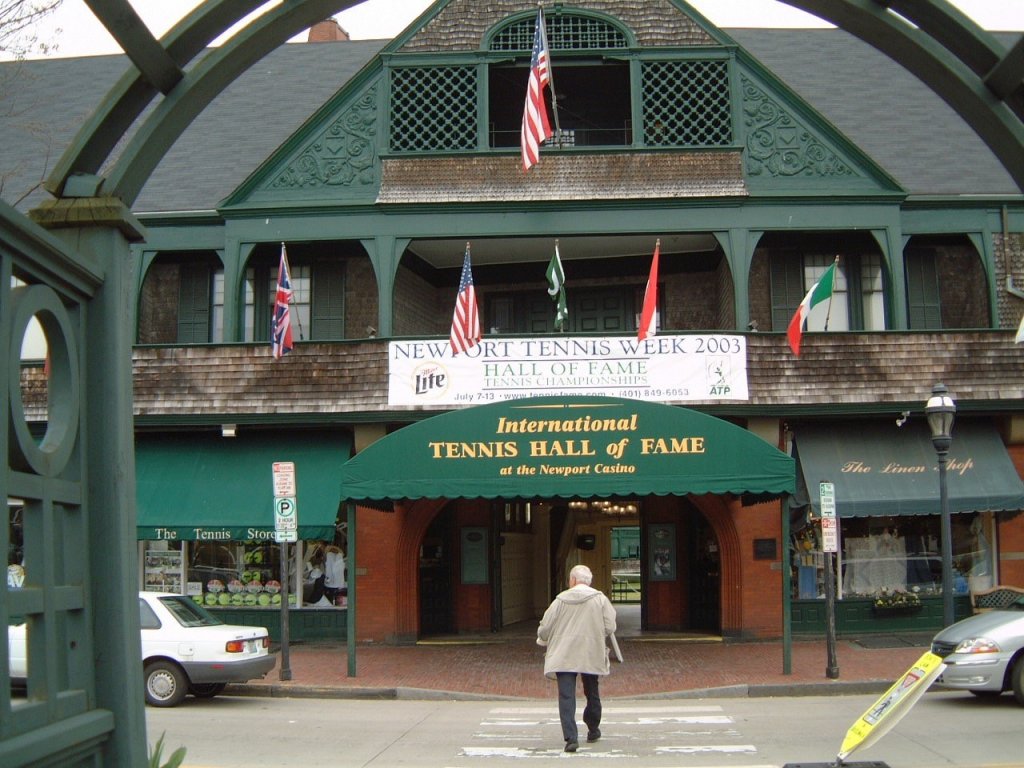 |
| INTERNATIONAL TENNIS HALL OF FAME |
Known as Newport’s “Sporting
Mansion”, this Stanford White structural masterpiece is one of the finest
examples of Victorian shingle-style architecture in the world. The 6-acre
complex features 13 grass tennis courts, a Royal Tennis Court, indoor tennis
facility, Bill Talbert Stadium Court, and Museum. The Casino was designed
as a social and sporting club for the Astors, Vanderbilts, and all of Newport
during the “Gilded Age”.
Mansion”, this Stanford White structural masterpiece is one of the finest
examples of Victorian shingle-style architecture in the world. The 6-acre
complex features 13 grass tennis courts, a Royal Tennis Court, indoor tennis
facility, Bill Talbert Stadium Court, and Museum. The Casino was designed
as a social and sporting club for the Astors, Vanderbilts, and all of Newport
during the “Gilded Age”.
Whether it is
a tennis complex, a mansion, or a mailbox, everything looms large in Newport,
Rhode Island.
a tennis complex, a mansion, or a mailbox, everything looms large in Newport,
Rhode Island.
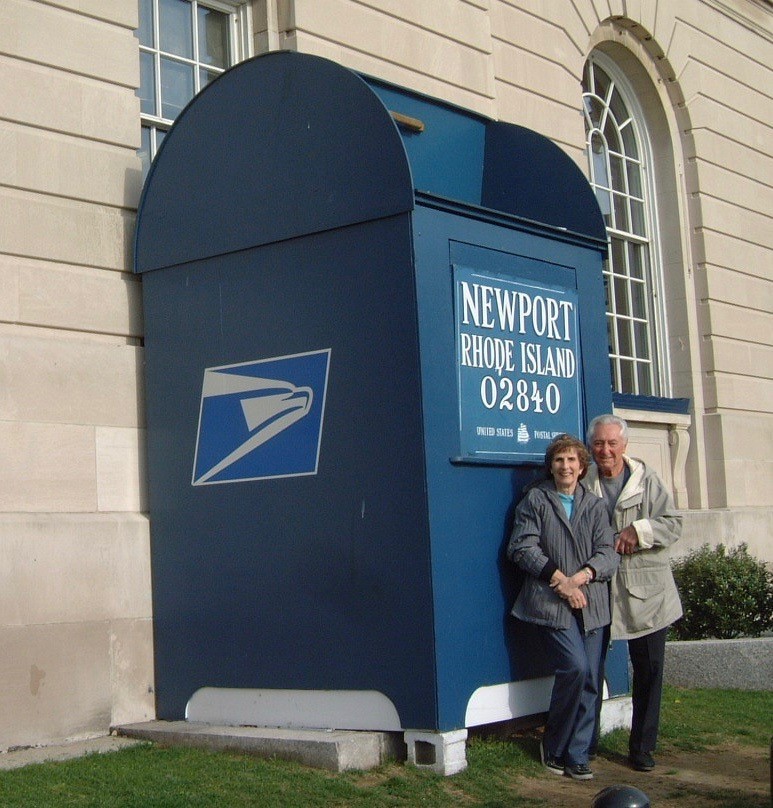 |
| EVERYTHING LOOMS LARGE IN NEWPORT, RHODE ISLAND |
JANET STEINBERG is an award-winning
Travel Writer, International Travel Consultant, and winner of 43 national
Travel Writing Awards.
Travel Writer, International Travel Consultant, and winner of 43 national
Travel Writing Awards.

